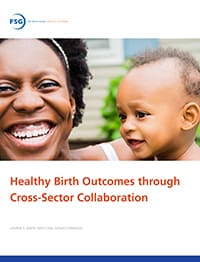Among Organisation for Economic Cooperation and Development (OECD) countries, the United States ranks near the bottom in infant mortality rates. This is particularly perilous for black babies in the U.S., who are more than twice as likely to die before their first birthday as a white baby. In addition to the medical care and access a woman and baby receive, these poor outcomes are also driven by social determinants of health—non-clinical factors such as social, educational, environmental, and economic opportunities that affect a woman’s overall health and wellbeing. This multi-faceted challenge requires a multi-faceted approach.
Cross-sector collaborations offer a way forward in their ability to direct multiple actors and interventions toward the same goal. In this report, we highlight lessons learned from two of our birth outcomes projects in Fresno County, California, and Staten Island, New York, to offer others insights into paths to success and challenges to be aware of when seeking to address birth outcomes through such collaborations.
Top Takeaways
- Despite the multiple elements that affect birth outcomes, initiatives must prioritize areas of focus to make effective progress.
- Initiatives must encourage the involvement and leadership of women of color and women living in poverty, who make up the primary populations facing adverse birth outcomes.
- Effective collaborations are built on a foundation of authentic and trusting relationships, both within the initiative members and with the wider community.
- Transformation of a system such as the one that affects birth outcomes requires a long-term plan and vision.
Learn more about FSG’s U.S. Health services >

